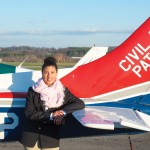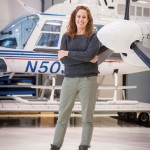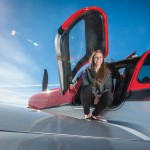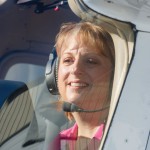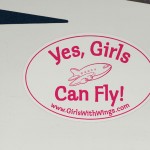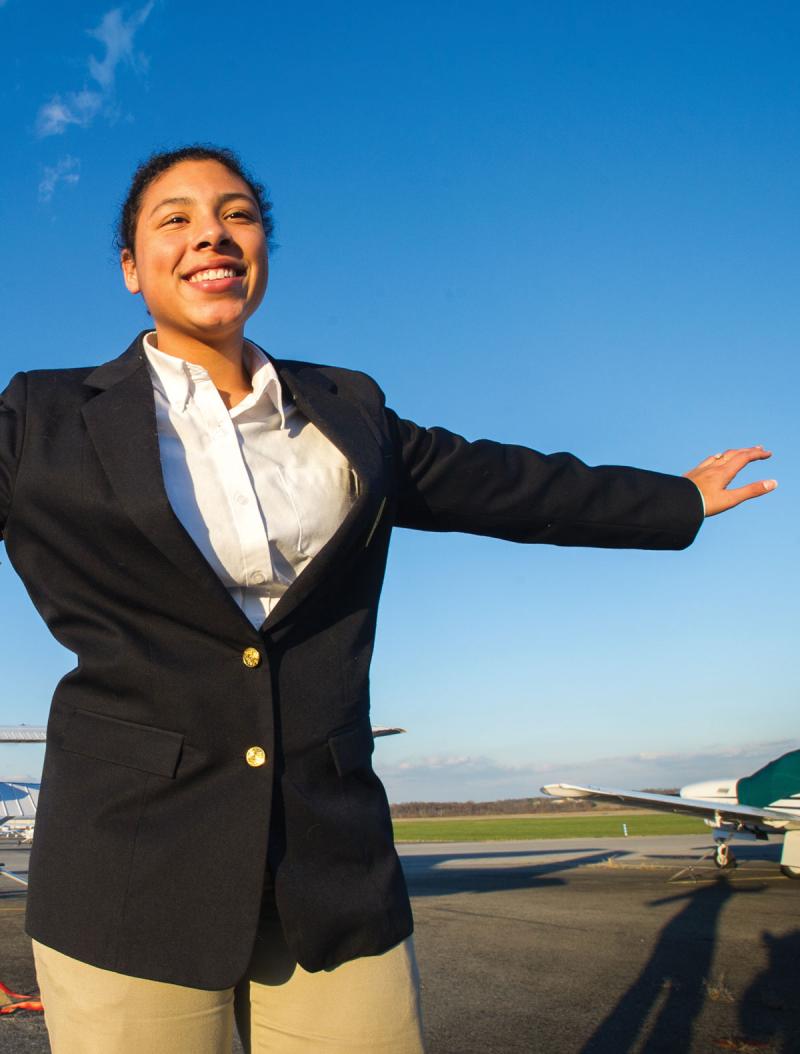
As a young girl in Japan, Nobuyo Sakata spent each night gazing up at the small inflatable airplane suspended over her bed as she drifted off to sleep. A gift from her grandfather, it often made her think about actually flying. But Sakata grew up believing that girls couldn’t become pilots, and her friends and family gently teased her about her fascination.
“If you grow up in a small town in Japan, you go to high school, maybe two or four years of college, then you meet someone and get married,” Sakata says.
But Sakata—now 48 and a resident of Darnestown, Md., near Gaithersburg—has “always wanted to do something unexpected.” So at age 16, she traveled from Japan to Missouri as an exchange student, and though her initial exposure to the United States was disappointing, she was nonetheless delighted by her first-ever commercial flight.
Six years later, while visiting a friend in Alaska, her desire to fly was refueled when she saw so many people working there as pilots, from sightseeing jobs to ones in goods transport: “It was a part of the daily life.”
Eventually, she returned to Japan, where she worked in administration for an American airline as a way to realize her passion for aviation in any form—later, back in the U.S., she earned double master’s degrees in tourism administration and project management from George Washington University, in D.C., before taking a job as a manager of operations and safety analysis with Airlines for America, a D.C.-based trade group.
But she still had no “wings” of her own, until, finally, at age 43, she began training at the Frederick Flight Center in Maryland, earning her private pilot license in 2013 at 46. Now a naturalized U.S. citizen, Sakata holds the post of director of aviation security at the Aircraft Owners and Pilots Association, located in Frederick.
“I think it’s the freedom and control,” Sakata says of flying’s innate appeal. “I see it as a part of my personality to be a pilot. I think God led me to this path, because one door opened to another, and somehow I’ve been in aviation for a while. It’s so unique to this country that people have the freedom to fly like they do. That’s part of my love about this country.”
The U.S. boasts a rich history of women aviators, some of whose exploits seized headlines. In 1932, Amelia Earhart famously became the first woman pilot to fly solo across the Atlantic Ocean. Five years later—even more famously—she vanished over the Central Pacific while attempting to circumnavigate the globe. In 1956, Jacqueline Cochran became the first woman pilot to shatter the sound barrier. Of course, in 1921, Bessie Coleman shattered a completely different kind of barrier as the first African-American female pilot.
Others’ accomplishments registered considerably lower on the radar screen, but were no less significant: For instance, Emily Howell Warner became the first woman to captain a major American airline commercial passenger flight in 1976. Not forgetting the aviators of the Women Airforce Service Pilots (headed by Cochran), who, during World War II ferried planes, including bombers, from site to site, plus flew planes towing targets for gunnery practice.
Still, women have always represented a small percentage of pilots overall. According to a study published by the Institute for Women of Aviation Worldwide (based on statistics provided by the Federal Aviation Administration), as of the end of 2013, nearly 600,000 pilots were licensed to fly in the U.S. But only slightly less than 40,000 of them—or 6.6 percent—were women. Subtract student licenses from that figure and the percentage dips to 4.2.
So while many women might share Nobuyo Sakata’s dream to fly, few actually end up soaring at home in the sky. Count Katie Higgins among those who live the dream—and then some. A captain in the U.S. Marine Corps, Higgins joined the Navy’s elite flight demonstration squadron, the Blue Angels, in 2014 as its first-ever female pilot, and now opens each of its spectacular air shows co-piloting a C-130 plane called “Fat Albert.”
“I didn’t come to the Blue Angels to break any glass ceilings,” says Higgins, 29, who calls Severna Park home. “I came to do my job to the best of my ability.”
Before signing on with the Blue Angels, she put in nearly 400 combat hours flying in Afghanistan, Africa and elsewhere, deciding on a military career because “I wanted to make the world and my country safer. I really felt like I wanted to make a difference.”
The squadron is on the road 300 days each year and performs approximately 70 shows across the country, which includes visits with more than 50,000 people at schools and hospitals. According to Higgins, she often hears, “‘I didn’t know girls could be pilots,’ so it’s definitely an honor to correct those misconceptions.”
In her St. John’s Catholic Prep school uniform of a dark blazer and khakis, Jordan Brown, 15, is one of those young women aiming to become a pilot. She’s all business, right down to her firm-bordering-on-bone-crushing handshake.
“Excellence, integrity, volunteer service and respect,” she says, rattling off the core principles of the Civil Air Patrol, the aerospace education and emergency training wing of the U.S. Air Force Auxiliary, of which she’s been a member since age 12.
“After my first orientation flight, I was hooked,” says Brown, who lives in New Market, Md., and is the recipient of a ground school scholarship from the Experimental Aircraft Association. “I’ve always loved the idea of flying, the feeling of being suspended—I’m a total adrenaline junkie. And it was just great to be in control of the airplane. I thought, ‘This is what God sees everyday, I can see what he sees—this is beautiful.’ Every time I’m in a plane, I think that.”
Lin Caywood, a member of the Sugarloaf chapter of the Ninety-Nines, an international organization of women pilots that promotes advancement of aviation, encouraged Brown’s mother to apply for her.
“The most empowering thing that I’ve ever done for myself is to learn how to fly,” Caywood says. “You’re in complete control and you’re flying a machine in the air. The freedom, the thrill and the serenity of being in the sky, it’s truly a passion.”
Caywood, 51, who also lives in Frederick, grew up on a farm along the Potomac River in the flight path of Dulles International Airport. “Concordes used to fly over and it was really loud,” she recalls. “You’d stop and look up at it —it was fascinating.”
When she was 36, she rode in a float plane in Alaska and thought, “I have to learn how to do this—it’s the coolest thing in the world.”
A mortgage banker by profession, Caywood is not only certified to fly float planes, but also has a private pilot license and owns a four-seat Cessna 182 with a top speed of 165 mph. “I’m out every weekend the weather is nice, either flying or as a passenger,” she says—her husband is also a pilot. “The only arguments we really have are who’s going to fly the plane. One of our favorite things is looking down over the Bay Bridge [en route to Ocean City] and seeing all the cars there or backed up on 95. It makes you feel pretty good to get past all that.”
Sarah Talucci understands that feeling. With her slight frame, warm smile and hair tied into a ponytail, Talucci, 25, points out all of the equipment and safety features as she leads a sales walk around a four-seat Cirrus SR-20 she has just landed at Signature Flight Support, near BWI, arriving from her home base in Frederick. As a business development representative for airplane manufacturer Cirrus, she flies a demo plane several times a week to meet with prospective buyers located anywhere within her four-state territory, providing them with test flights.
“It’s the best of both worlds,” says Talucci, who began flying at age 18 and formerly worked as a charter pilot captain. “I still get to fly airplanes and work for an amazing company, but I get to come home at the end of the day.”
Melissa Torres’ experience with airports and planes began at an even earlier age. As a young girl, she traveled regularly from Philadelphia to visit relatives in Paraguay. Even as a passenger, the fascination and appeal of flying stuck with her.
“But I never thought I could be a pilot,” she says. “I was a girl, and I [also] thought you had to be a military pilot.”
Eventually, she learned otherwise, and when she and her husband, a doctor in the military, were stationed in Newport News, Va., she headed over to Williamsburg’s airport and learned to fly from “this old guy, a World War II fighter pilot,” ultimately earning her private pilot license and instrument rating.
“I just love the sky—it doesn’t matter what vehicle it’s in,” says Torres, 48, who now flies both helicopters and airplanes for the Frederick-based aerial photography land survey company Richard Crouse and Associates.
On the move again and laser-focused on becoming a commercial airline pilot, Torres relocated to Bethesda, where she earned money for lessons to obtain commercial certification by doing database entry work. Clocking flight hours is required for a commercial pilot license, and while flying a Piper Arrow training plane during a solo trip in 1998, the aircraft experienced a malfunction, forcing Torres to land knowing its landing gear would collapse.
“That’s the moment I said, ‘I can do this for a living,” Torres says. “I was calm. It worked, all the training, everything they teach you, it worked.”
A few months later, as she neared completing hours to test for her commercial license, her instructor told her the Piper Arrow had been repaired and returned. But she had since become familiar with flying another plane. “Let’s skip this weekend,” she recalls saying. That same weekend, the plane crashed, killing both a student and instructor.
As a new mother negotiating her husband’s frequent military relocations, plus lacking the necessary funds to continue lessons, Torres stopped flying for about 12 years.
Then, in 2010, she finally got her commercial license and was even offered a job, but “reality hit, and I thought, ‘How will I do this with three kids at home?’”
Forgoing an airlines career left Torres craving another challenge, so she turned to helicopters: “My intention was to just fly them for fun,” she says. “Then, because I had both licenses, [the land surveying job] kind of fell into my lap.” She’s worked at RCA for more than two years.
Finishing for the day in the company’s hangar and walking toward her own red- and-white Super Decathlon aerobatic plane, Torres’ face lights up. “When [my boss and I] need to get away from everything,” she says, “we take it up and do spins. I just love it. Flying is like a freedom. It’s peaceful, it’s beautiful, it’s challenging sometimes. It’s different every time. It’s not an office—it’s just a freedom.”


